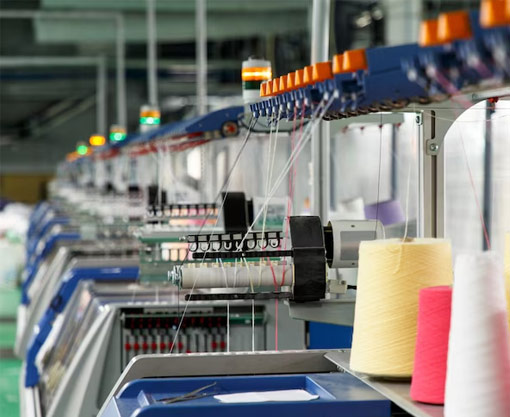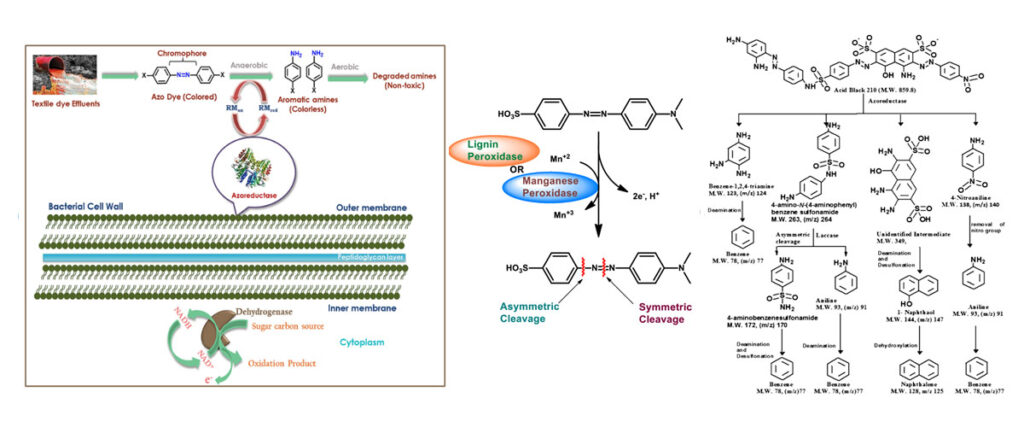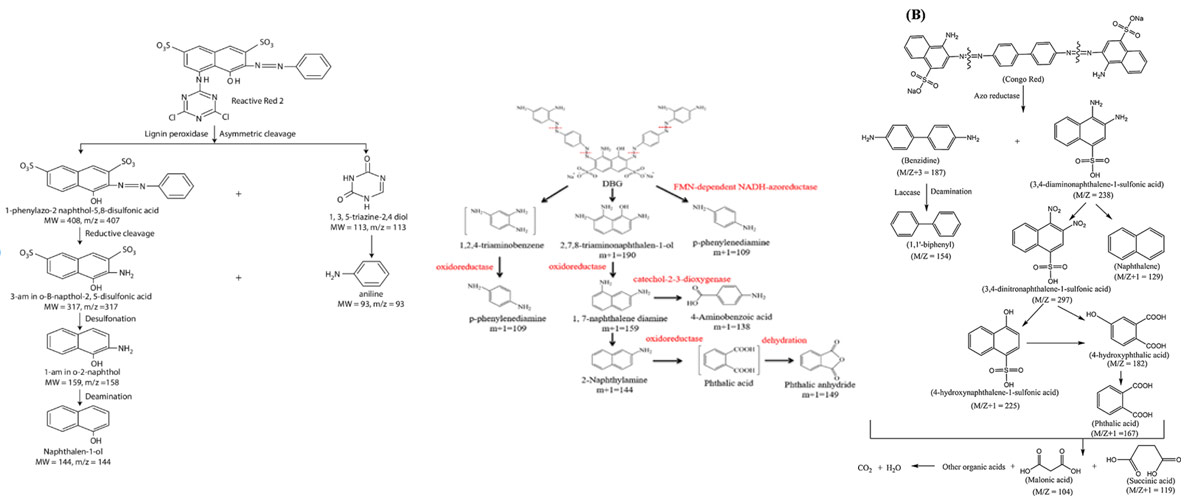



Textile industries are responsible for one of the major environmental pollution problems in the world, because they release undesirable dye effluents. Textile wastewater contains dyes mixed with various contaminants at a variety of ranges. Therefore, environmental legislation commonly obligates textile factories to treat these effluents before discharge into the receiving watercourses. Textile industries positively affect the economic development worldwide. However, one of the problems associated with textile factories is the unacceptable effluent, especially dyes, which are difficult to degrade.
The classification of textile industries depends on the type of fabrics they produce, including cellulosic materials obtained from plants (e.g. cotton, rayon and linen), protein fabrics, which come from animals (e.g. wool, silk and mohair), and synthetic fabrics produced artificially (e.g. nylon, polyester and acrylic). Fibre production in textile factories includes dry and wet processes. The wet process uses a considerable quantity of potable water and releases highly contaminated wastewater. This process consists of sizing, de-sizing, sourcing, bleaching, mercerising, dyeing, printing and finishing techniques.
The dyeing process is an important step in textile manufacturing. During this stage, the colour is added to the fibres, and different chemicals may be used to improve the adsorption process between colour and fibres. When the final product is ready after the finishing process, some of these dyes and chemicals become part of the textile industry effluents. These dyes and chemicals, in addition to their unacceptable appearance and toxic effect after their breakdown, may contaminate the nearby soil, sediment and surface water, becoming a major global environmental pollution challenge. The treatment of textile effluents is necessary to protect the ecosystem and enable subsequent recycling of the treated effluent for irrigation purposes or reuse within the textile factory processes.
The effluents discharged from textile factories are a mixture of dyes, metals and other pollutants. The colourants can be divided into natural and synthetic dyes. The synthetic dyes are produced easily, in different colours, and characterised by their fastness, which makes them more widely used than natural dyes. Synthetic dyes are classified into different groups according to their chemical structure (e.g. azo, anthraquinone, sulphur, phthalocyanine and triarylmethane) and according to their mode of application (e.g. reactive, direct, disperse, basic and vat dying).
The dye effluents are high in colour, pH, suspended solids (SS), chemical oxygen demand (COD), biochemical oxygen demand (BOD), metals, temperature and salts. Therefore, during the treatment processes, it is important to monitor and compare these parameters with the standard concentrations before discharging the corresponding effluent to the receiving water body. Monitoring of the treatment performance regarding other parameters such as total organic carbon (TOC), ammonia–nitrogen (NH4–N), nitrate–nitrogen (NO3–N) and ortho-phosphate–phosphorus (PO4–P) is also required.
TEXTILE & DYING EFFLUENT – Range of Products |
NANOZYME – BET – ETP – 7001 |
NANOZYME – BET – ETP – 7002 |
NANOZYME – BET – ETP – 7003 |
The effluents generated from textile dyeing units create major environmental problems and issues both in public and textile units. Industrial wastewater treatment is one of the major problems in the present scenario. Generally, synthetic dyes can be classified as anionic (direct, acid and reactive dyes), cationic (basic) and non-ionic (disperse). Anionic dyes (direct, acid and reactive) represent 20–30% of commercial dyes used. Azo dyes are the largest chemical class of dyes with a great deal of structural and colour variety used in industries representing up to 70% of the annual production.
Synthetic dyes are released into the environment from textile industrial effluents the release of dyes into the environment constitutes only a small proportion of water pollution, but dyes are visible in small quantities due to their brilliance. Tightening government legislation is forcing textile industries to treat their waste effluent to an increasingly high standard. The main important pollutants in textile effluent are recalcitrant organic compounds, colour, toxicant, inhibitory compounds, surfactants and chlorinated compounds. During processing, 5–20% of the used dyestuffs are released into the process waterand. In addition to their visual effect and their adverse impact in terms of chemical oxygen demand, many synthetic dyes are toxic, mutagenic and carcinogenic.
AVAILABLE FORM ORGANIC SEMI-SOLID FORM
The chemical industry is of importance in terms of its impact on the environment. The wastewaters from this industry are generally strong and may contain toxic pollutants. Chemical industrial wastes usually contain organic and inorganic matter in varying degrees of concentration. It contains acids, bases, toxic materials, and matter high in biological oxygen demand, color, and low in suspended solids. Many materials in the chemical industry are toxic, mutagenic, carcinogenic or simply hardly biodegradable. Surfactants, emulsifiers and petroleum hydrocarbons that are being used in chemical industry.
An enzyme is a globular protein with an active site which bind to substrate molecules and helps to catalyse a reaction by holding molecules in the correct spatial conformation for the reaction to take place. The activities of the enzymes are determined by their 3-dimensional structure. Most enzymes are much larger than the substrates they act on and only a small portion of the enzyme around 3-4 aminoacids is directly involved in catalysis.
Nanozyme are based on the latest advanced technology in biotechnology designed to meet the requirements of specific waste water treatment problems. Biological treatment method by Nanozyme microbes is the only method that can eliminate/degrade the waste problem. Specially selected and acclimated strains of microorganisms supplied in NANOZYME microbial enzyme products produce millions of times the levels of organic digesting catalysts produced by various type of microorganisms found naturally in different waste. Bacteria are living organisms that continually adapt and grow in the system.
Nanozyme Effective Microorganism (EM) is the consortia of valuable microorganisms which secretes organic acids and enzymes for utilization and degradation of anthropogenic compounds. Combination of various strains will successively promotes the growth of bacterial population, break down and digest the waste in both aerobic and anaerobic conditions to a far greater degree than single microbial strain. Bioremediation process involves detoxification and mineralization, where the waste is converted into inorganic compounds such as carbon dioxide, water and methane. When compounds are persistent in the environment, their biodegradation often proceeds through multiple steps utilizing different enzyme systems or different microbial populations.
Nanozyme microbial technique for textile dye degradation will be eco-friendly and is probably a lucrative alternative to physico-chemical processes. Nanozyme Microbial enzymes, viz. laccase and azoreductase, are cost-efficient, easily downstream processable, and effortlessly mobilizable. Nanozyme microbial enzyme conjugates are highly efficient to remove the azo dye from textile waste.
The degradation of dyes by Nanozyme bacteria is facilitated by their oxidases. In the case of azo dyes, azoreductase plays the most vital role in decolorization by breaking down azo bonds.


Nanozyme Bacterial digestion is the process of bacteria, consuming organic & Inorganic matter. Enzymes act to break the organic& Inorganic matter into water soluble nutrients, which the bacteria digest. Using complex chemical reactions, the organic & Inorganic waste is metabolized down to water and carbon dioxide (the final metabolic waste products), providing the bacteria with energy for growth and reproduction. It may be simply shown by the following equation:
Organic waste + Water Soluble Nutrients —–Bacteria + oxygen—> water + carbon dioxide
Organic waste + Water ——Enzyme—-> Water Soluble Nutrients —–Bacteria—> Water + Carbon Dioxide
We are using our product nanozyme in aeration tank capacity which means the ammonical nitrogen totally converted into nitrate nitrogen. It’s an available intake form to our bacteria. So totally we can eliminate the odour and control the ammoniacal nitrogen…. odour is because of ammonical and hydrogen sulphide. No need to remove condensate.
Note that a total ammonia value (NH3 + NH4) cannot be trivially converted from “nitrogen” to “ion” form or vice versa. The total ammonia value must first be broken into component NH3 and NH4 values, then converted individually to NH3-N and NH4-N and added together.
Ammonia removal is a strictly aerobic biological process. Technically, bacteria convert ammonia (NH4 ) to nitrate (NO3 ); it isn’t really “removed.” Nitrification only works on ammonia (NH4 ). Organic-nitrogen is not converted directly to nitrate (NO3 ); it must first be converted to ammonia (NH4 ), and the ammonia (NH4 ) converted to nitrite (NO2 ) and then nitrate (NO3 ).
Organic / Inorganic pollutant load is consumed by the bacteria, used as nutrients by the bacteria, and is no longer present to produce odours, sludge, pollution, or unsightly mess.
The removal of pollutants from the Effluent by using NANOZYME (Effective Microbes (EM)- bacterial consortium manufactured in BIONICS ENVIRO TECH having potential to degrade all organic and inorganic compounds present in the Effluent.
When degradation Organic and inorganic take place which will automatically lead to reduction of COD, When COD takes places which will reflect BOD, Color, smell and etc parameters.
| S.No | PRODUCT DESCRIPTION | UNIT | Quantity | |
|---|---|---|---|---|
| 1 | NANOZYME BET-ETP-7003 PRO | Kgs | 100 | |
| 2 | NANOZYME BET-NUTRI-9003 | Kgs | 50 |
REQUIRED MATERIALS FOR PREPARATION:
NANOZYME INCUBATION METHOD:
| Dosage | Day of Dosage | From 10000 litres of prepared broth Volume of Nanozyme Application to Aeration | ||
|---|---|---|---|---|
| 1st Dosage | 1st to 10 days | 100 Litres / Day | ||
| 2nd Dosage | 11th to 20th Days | 100 Litres / Day | ||
| 3rd Dosage | 21st to 30th Days | 100 Litres / Day |